Pharmacotherapy for hyperuricaemia in hypertensive patients
- PMID: 32877573
- PMCID: PMC8094453
- DOI: 10.1002/14651858.CD008652.pub4
Pharmacotherapy for hyperuricaemia in hypertensive patients
Abstract
Background: This is the second update of this systematic review. High blood pressure represents a major public health problem. Worldwide, approximately one-fourth of the adult population has hypertension. Epidemiological and experimental studies suggest a link between hyperuricaemia and hypertension. Hyperuricaemia affects 25% to 40% of those with untreated hypertension; a much lower prevalence has been reported in those with normotension or in the general population. However, whether lowering serum uric acid (UA) might lower blood pressure (BP), is an unanswered question.
Objectives: To determine whether UA-lowering agents reduce BP in people with primary hypertension or prehypertension, compared with placebo.
Search methods: The Cochrane Hypertension Information Specialist searched the following databases for randomised controlled trials up to May 2020: the Cochrane Hypertension Specialised Register, CENTRAL 2018, Issue 12, MEDLINE (from 1946), Embase (from 1974), the World Health Organization International Clinical Trials Registry Platform, and ClinicalTrials.gov. We also searched LILACS (1982 to May 2020), and contacted authors of relevant papers regarding further published and unpublished work. The searches had no language or date restrictions.
Selection criteria: To be included in this updated review, the studies had to meet the following criteria: 1) randomised or quasi-randomised, with a group assigned to receive a UA-lowering agent and another group assigned to receive placebo; 2) double-blind, single-blind, or open-label; 3) parallel or cross-over trial design; 4) cross-over trials had to have a washout period of at least two weeks; 5) minimum treatment duration of four weeks; 6) participants had to have a diagnosis of essential hypertension or prehypertension plus hyperuricaemia (serum UA greater than 6 mg/dL in women, 7 mg/dL in men, and 5.5 mg/dL in children or adolescents); 7) outcome measures included change in 24-hour ambulatory systolic or diastolic BP, or both; or clinic-measured systolic or diastolic BP, or both.
Data collection and analysis: The two review authors independently collected the data using a data extraction form, and resolved any disagreements via discussion. We assessed risk of bias using the Cochrane 'Risk of bias' tool. We assessed the certainty of the evidence using the GRADE approach.
Main results: In this review update, we screened 722 records, selected 26 full-text reports for evaluation. We identified no ongoing studies and did not add any new studies. We included three randomised controlled trials (RCTs), enrolling 211 people with hypertension or prehypertension, plus hyperuricaemia. Low-certainty evidence from three RCTs found inconclusive results between those who received UA-lowering drugs and placebo, in 24-hour ambulatory systolic (MD -6.2 mmHg, 95% CI -12.8 to 0.5) or diastolic BP (-3.9 mmHg, 95% CI -9.2 to 1.4). Low-certainty evidence from two RCTs found that UA-lowering drugs reduced clinic-measured systolic BP (-8.43 mmHg, 95% CI -15.24 to -1.62) but results for clinic-measured diastolic BP were inconclusive (-6.45 mmHg, 95% CI -13.60 to 0.70). High-certainty evidence from three RCTs found that serum UA levels were reduced by 3.1 mg/dL (95% CI 2.4 to 3.8) in the participants that received UA-lowering drugs. Low-certainty evidence from three RCTs found inconclusive results regarding the occurrence of adverse events between those who received UA-lowering drugs and placebo (RR 1.86, 95% CI 0.43 to 8.10).
Authors' conclusions: In this updated Cochrane Review, the current RCT data are insufficient to know whether UA-lowering therapy lowers BP. More studies are needed.
Trial registration: ClinicalTrials.gov NCT01472692.
Copyright © 2020 The Cochrane Collaboration. Published by John Wiley & Sons, Ltd.
Conflict of interest statement
Gois P: nothing to declare
Souza E: nothing to declare
Figures
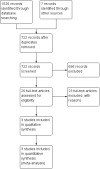
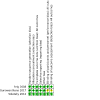
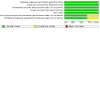
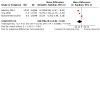
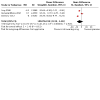
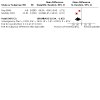
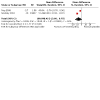
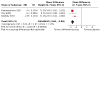

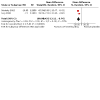
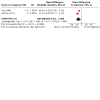
Update of
-
Pharmacotherapy for hyperuricemia in hypertensive patients.Cochrane Database Syst Rev. 2017 Apr 13;4(4):CD008652. doi: 10.1002/14651858.CD008652.pub3. Cochrane Database Syst Rev. 2017. Update in: Cochrane Database Syst Rev. 2020 Sep 2;9:CD008652. doi: 10.1002/14651858.CD008652.pub4. PMID: 28406263 Free PMC article. Updated.
References
References to studies included in this review
Feig 2008 {published data only}
Gunawardhana 2017 {published and unpublished data}
-
- Gunawardhana L, McLean L, Punzi HA, Hunt B, Palmer RN, Whelton A, et al. Effect of febuxostat on ambulatory blood pressure in subjects with hyperuricemia and hypertension: a phase 2 randomized placebo-controlled study. Journal of the American Heart Association 4 November 2017;6(11):e006683. - PMC - PubMed
-
- NCT01496469. Effect of febuxostat on blood pressure [A phase 2, double-blind, placebo-controlled study to assess the effect of febuxostat 80 mg once daily compared to placebo on ambulatory blood pressure in subjects with hyperuricemia and hypertension]. clinicaltrials.gov/ct2/show/NCT01496469 (first received 18 December 2011).
Soletsky 2012 {published data only}
-
- Soletsky B, Feig DI. Uric acid reduction rectifies prehypertension in obese adolescents. Hypertension 2012;60(5):1148-56. - PubMed
References to studies excluded from this review
Assadi 2014 {published data only}
-
- Assadi F. Allopurinol enhances the blood pressure lowering effect of enalapril in children with hyperuricemic essential hypertension. Journal of Nephrology 2014;27(1):51-6. - PubMed
Feig 2004 {published data only}
-
- Feig DI, Nakagawa T, Karumanchi SA, Oliver WJ, Kang DH, Finch J, et al. Hypothesis: uric acid, nephron number, and the pathogenesis of essential hypertension. Kidney International 2004;66(1):281-7. - PubMed
Higgins 2014 {published data only}
-
- Higgins P, Walters MR, Murray HM, McArthur K, McConnachie A, Lees KR, et al. Allopurinol reduces brachial and central blood pressure, and carotid intima-media thickness progression after ischaemic stroke and transient ischaemic attack: a randomised controlled trial. Heart 2014;100(14):1085-92. - PubMed
Horino 2017 {published data only}
-
- Horino T, Hatakeyama Y, Ichii O, Matsumoto T, Shimamura Y, Inoue K, et al. Effects of topiroxostat in hyperuricemic patients with chronic kidney disease. Clinical and Experimental Nephrology 2018;22(2):337-45. - PubMed
Hosoya 2014 {published data only}
Jalalzadeh 2012 {published data only}
Kanbay 2007 {published data only}
-
- Kanbay M, Ozkara A, Selcoki Y, Isik B, Turgut F, Bavbek N, et al. Effect of treatment of hyperuricemia with allopurinol on blood pressure, creatinine clearance, and proteinuria in patients with normal renal function. International Urology and Nephrology 2007;39(4):1227-33. - PubMed
Kanbay 2011 {published data only}
-
- Kanbay M, Huddam B, Azak A, Solak Y, Kadioglu GK, Kirbas I, et al. A randomized study of allopurinol on endothelial function and estimated glomerular filtration rate in asymptomatic hyperuricemic subjects with normal renal function. Clinical Journal of the American Society of Nephrology 2011;6(8):1887-94. - PMC - PubMed
Kim 2014 {published data only}
Kostka‐Jeziorny 2011 {published data only}
-
- Kostka-Jeziorny K, Uruski P, Tykarski A. Effect of allopurinol on blood pressure and aortic compliance in hypertensive patients. Blood Pressure 2011;20(2):104-10. - PubMed
Madero 2015 {published and unpublished data}
-
- Madero M, Castellanos FER, Jalal D, Villalobos-Martın M, Salazar J, Vazquez-Rangel A, et al. A pilot study on the impact of a low fructose diet and allopurinol on clinic blood pressure among overweight and prehypertensive subjects: a randomized placebo controlled trial. Journal of the American Society of Hypertension 2015;9(11):837-44. - PubMed
McMullan 2017 {published data only}
Ohta 2017 {published data only}
-
- Ohta Y, Ishizuka A, Arima H, Hayashi S, Iwashima Y, Kishida M, et al. Effective uric acid-lowering treatment for hypertensive patients with hyperuricemia. Hypertension Research 2017;40(3):259-63. - PubMed
Peixoto 2001 {published data only}
-
- Peixoto MRG, Monego ET, Jardim PCBV, Carvalho MM, Sousa ALL, Oliveira JS, et al. Diet and medication in the treatment of hyperuricemia in hypertensive patients. Arquivos Brasileiros de Cardiologia 2001;76(6):468-72. - PubMed
Pour‐Pouneh 2015 {published data only}
-
- Pour-Pouneh M, Narimani R, Mardani S, Momeni A, Nasri H. Evaluation of the relationship between the reduction of serum uric acid level and control of blood pressure in patients with hypertension and hyperuricemia. Journal of Isfahan Medical School 2015;33:1672-85.
Schakis 2004 {published data only}
-
- Schackis RC. Hyperuricaemia and preeclampsia: is there a pathogenic link? Medical Hypotheses 2004;63(2):239-44. - PubMed
Segal 2015 {published data only}
Sezai 2013 {published data only}
-
- Sezai A, Soma M, Nakata K, Hata M, Yoshitake I, Wakui S, et al. Comparison of febuxostat and allopurinol for hyperuricemia in cardiac surgery patients (NU-FLASH Trial). Circulation Journal 2013;77(8):2043-9. - PubMed
Sharbaf 2018 {published data only}
-
- Sharbaf FG, Assadi F. Effect of allopurinol on the glomerular filtration rate of children with chronic kidney disease. Pediatric Nephrology 2018;33(8):1405–9. - PubMed
Siu 2006 {published data only}
-
- Siu YP, Leung KT, Tong MKH, Kwan TH. Use of allopurinol in slowing the progression of renal disease through its ability to lower serum uric acid level. American Journal of Kidney Disease 2005;47(1):51-9. - PubMed
Tani 2015 {published data only}
-
- Tani S, Nagao K, Hirayama A. Effect of febuxostat, a xanthine oxidase inhibitor, on cardiovascular risk in hyperuricemic patients with hypertension: a prospective, open-label, pilot study. Clinical Drug Investigation 2015;35(12):823-31. - PubMed
Tsuji 2017 {published data only}
-
- Tsuji T, Ohishi K, Takeda A, Goto D, Sato T, Naro Ohashi N, et al. The impact of serum uric acid reduction on renal function and blood pressure in chronic kidney disease patients with hyperuricemia. Clinical and Experimental Nephrology 2018;22(6):1300-8. - PubMed
Whelton 2011 {published data only}
-
- Whelton A, Macdonald P, Hunt B, Gunawardhana L. Hypertension in hyperuricemic gout subjects receiving febuxostat or allopurinol. Journal of Clinical Hypertension 2011;13(S1):A57.
References to studies awaiting assessment
Gaffo 2019 {unpublished data only}
-
- Gaffo A, Calhoun D, Rahn E, Oparil S, Muntner P, Peng L, et al. Effect of serum urate lowering with allopurinol on blood pressure in young adults. Annals of the Rheumatic Diseases 2019;78(S2):A180.
Pendon‐Ruiz De Mier 2018 {unpublished data only}
-
- Pendon-Ruiz De Mier V, Vergara N, Santamaria R, Buendia P, Martinez-Moreno J, Jimenez-Moral M, et al. Effect of allopurinol on endothelial function, blood pressure, arterial stiffness and renal damage in patients with chronic kidney disease and asymptomatic hyperuricemia. Journal of Hypertension June 2018;36(e-Supplement 1):e184.
Additional references
Agarwal 2013
Alper 2005
-
- Alper AB Jr, Chen W, Yau L, Srinivasan SR, Berenson GS, Hamm LL. Childhood uric acid predicts adult blood pressure: the Bogalusa Heart Study. Hypertension 2005;45(1):34-8. - PubMed
Cannon 1966
-
- Cannon PJ, Stason WB, Demartini FE, Sommers SC, Laragh JH. Hyperuricemia in primary and renal hypertension. New England Journal of Medicine 1966;275(9):457–64. - PubMed
Carretero 2000
-
- Carretero OA, Oparil S. Essential hypertension: part I: definition and etiology. Circulation 2000;101(3):329-35. - PubMed
Chobanian 2003
-
- Chobanian AV, Bakris GL, Black HR, Cushman WC, Green LA, Izzo JL Jr, et al. The Seventh Report of the Joint National Committee on Prevention, Detection, Evaluation and Treatment of High Blood Pressure: the JNC 7 report. Journal of the American Medical Association 2003;289(19):2560-72. - PubMed
de A Coutinho 2007
-
- A Coutinho T, Turner ST, Kullo IJ. Serum uric acid is associated with microvascular function in hypertensive individuals. Journal of Human Hypertension 2007;21(8):610-5. - PubMed
Falkner 2004
-
- Falkner B, Daniels SR, Flynn JT, Gidding S, Green LA, Ingelfinger JR, et al: the National High Blood Pressure Education Program Working Group on High Blood Pressure in Children and Adolescents. The Fourth Report on the Diagnosis, Evaluation, and Treatment of High Blood Pressure in Children and Adolescents. Pediatrics 2004;114:555-76. - PubMed
Feig 2006
-
- Feig DI, Mazzali M, Kang DH, Nakagawa T, Price K, Kannelis J, et al. Serum uric acid: a risk factor and a target for treatment? Journal of the American Society of Nephrology 2006;17:S69–73. - PubMed
Germino 2009
-
- Germino W. The management and treatment of hypertension. Clinical Cornerstone 2009;9(Suppl 3):S27-33. - PubMed
Gois 2013
GRADEpro GDT [Computer program]
-
- GRADEpro GDT. Version accessed 11 May 2020. Hamilton (ON): McMaster University (developed by Evidence Prime), 2015. Available at gradepro.org.
Higgins 2011
-
- Higgins JP, Green S editor(s). Cochrane Handbook for Systematic Reviews of Interventions Version 5.1.0 (updated March 2011). The Cochrane Collaboration, 2011. Available from handbook.cochrane.org.
Hunt 1991
-
- Hunt SC, Stephenson SH, Hopkins PN, Williams RR. Predictors of an increased risk of future hypertension in Utah. A screening analysis. Hypertension 1991;17:969-76. - PubMed
Johnson 2005
-
- Johnson RJ, Feig DI, Herrera-Acosta J, Kang DH. Resurrection of uric acid as a causal risk factor in essential hypertension. Hypertension 2005;45:18-20. - PubMed
Kasper 2004
-
- Kasper DL, Braunwald E, Hauser S, Longo D, Jameson JL, Fauci AS. Harrison's Principles of Internal Medicine. 16th edition. McGraw-Hill, 2004.
Kearney 2005
-
- Kearney PM, Whelton M, Reynolds K, Muntner P, Whelton PK, He J. Global burden of hypertension: analysis of worldwide data. Lancet 2005;365(9455):217-23. - PubMed
Kinsey 1961
-
- Kinsey D, Walther R, Sise HS, Whitelaw G, Smithwick R. Incidence of hyperuricemia in 400 hypertensive subjects. Circulation 1961;24:972-3.
Mazzali 2002
-
- Mazzali M, Kanellis J, Han L, Feng L, Xia YY, Chen Q, et al. Hyperuricemia induces a primary renal arteriolopathy in rats by a blood pressure-independent mechanism. American Journal of Physiology - Renal Physiology 2002;282:F991–7. - PubMed
Mittal 2010
-
- Mittal BV, Singh AK. Hypertension in the developing world: challenges and opportunities. American Journal of Kidney Diseases 2010;55(3):590-8. - PubMed
Ouppatham 2008
-
- Ouppatham S, Bancha S, Choovichian P. The relationship of hyperuricemia and blood pressure in the Thai army population. Journal of Postgraduate Medicine 2008;54(4):259-62. - PubMed
Perlstein 2006
-
- Perlstein TS, Gumieniak O, Williams GH, Sparrow D, Vokonas PS, Gaziano M, et al. Uric acid and the development of hypertension: the Normative Aging Study. Hypertension 2006;48:1031-6. - PubMed
Poon 2009
-
- Poon SH, Hall HA, Zimmermann B. Approach to the treatment of hyperuricemia. Medicine and Health, Rhode Island 2009;92(11):359-62. - PubMed
Review Manager 2014 [Computer program]
-
- Review Manager 5 (RevMan 5). Version 5.3. Copenhagen: Nordic Cochrane Centre, The Cochrane Collaboration, 2014.
Sachs 2009
-
- Sachs L, Batra KL, Zimmermann B. Medical implications of hyperuricemia. Medicine and Health, Rhode Island 2009;92(11):353-5. - PubMed
Sundström 2005
-
- Sundström J, Sullivan L, D'Agostino RB, Levy D, Kannel WB, Vasan RS. Relations of serum uric acid to longitudinal blood pressure tracking and hypertension incidence. Hypertension 2005;45:28-33. - PubMed
Taniguchi 2001
-
- Taniguchi Y, Hayashi T, Tsumura K, Endo G, Fujii S, Okada K. Serum uric acid and the risk for hypertension and type 2 diabetes in Japanese men: the Osaka Health Survey. Journal of Hypertension 2001;19(7):1209-15. - PubMed
Trachtman 2007
-
- Trachtman H. Treatment of hyperuricemia in essential hypertension. Hypertension 2007;49:e45. - PubMed
Williams 2010
-
- Williams B. The year in hypertension. Journal of the American College of Cardiology 2010;55(1):65-73. - PubMed
References to other published versions of this review
Gois 2013a
Publication types
MeSH terms
Substances
Associated data
LinkOut - more resources
Full Text Sources
Medical

